ISSN: 1204-5357
ISSN: 1204-5357
| MASHOOD MUKHTAR, PhD Student MBA Finance, University of Gloucestershire, United Kingdom Postal Address: The Park, Cheltenham, Gloucestershire GL50 2RH, UK Organizational Website: www.glos.ac.uk/ Email: mashoodmukhtar@hotmail.com |
| Mashood Mukhtar received his Master of Engineering (M.Eng.) degree from Queen Mary, University of London in 2011. He obtained Master of Business and Administration (MBA) in Finance from University of Gloucestershire, UK in 2013. He is currently pursuing PhD with the department of Electronic and Computer Engineering, Brunel University, London. His research interests include Artificial Intelligence and Humanoid Robot. |
| © Mashood Mukhtar, 2014 |
Visit for more related articles at Journal of Internet Banking and Commerce
Internet banking is becoming increasingly popular due to convenience and flexibility it offers. Banks are forced to promote online banking services to enhance its operations with reduced cost of operations. This particular research has been conducted to evaluate the customer perceptions towards internet banking in the United Kingdom. A sample of 100 UK based banking customers was selected. The sample selection was made by the convenience sampling technique. Qualitative and quantitative methods have been applied to evaluate the research objectives. Through descriptive analysis of research findings, it has been evaluated that customers perceive internet banking services reliable and secure. However, some of the older respondents did not feel convenient to use internet banking and they might have higher security concerns while using internet banking. The dimensions of privacy, security, convenience and time savings was perceived positively by the customers. The research represents future implications for the internet bankers who can attract more online customers by arranging stronger measures of security, and privacy. The results of this particular research are limited to the sample size and questionnaire made. The future researchers have the opportunity to expand the boundary of knowledge of current research by taking a large and diverse sample.
Keywords |
| internet banking; UK banking sector; online service; customer’s altitude; banking in the UK |
INTRODUCTION |
| This particular research has been focused on the internet banking. In this chapter, a context or background of the research has been created. Moreover, problem's statement and the purpose of conducting this research are also elaborated in this chapter. |
| Research Context |
| In the recent years, technology has gone through marvellous changes. The developments and innovation in technology and a hard line blend of these with the information technology have resulted in a significant paradigm shift in the banking sector from traditional online banking system. Technological developments have resulted in the creation of a global world which is also one of the motivating forces behind development of internet banking. Internet banking is simply considered as a system by which individuals, businesses or customers have access to their accounts, transact or transfer money, pay bills, obtain information regarding bank accounts and avail other banking related services through internet. The development in internet banking started in the late 1980s (Nami, 2009). At that time, what internet banking offered was much different from the internet banking services of the current era. |
| In the current era, three features cannot be defined or ignored. First, throat cut competition among the companies, shortage of time due to multiple tasks and using latest technology for accomplishing personal and business requirements. In the current environment, the businesses that have the ability to cope with all the above factors are more likely to survive whereas others are destined to extinction (Polasik & Wisniewski, 2009). Because of increasing competition in the banking industry customers want less costly, efficient and effective products and services. In addition, because of multiple commitments and engagements, customers also perceive to attain quick services. In the past, the banking industry was not highly developed and customers had to stand in the long queues for cash withdrawal, payment of bills and making money deposits. At that time, the banks used to make their physical operations and processes efficient to reduce the long queues. Later on, banks started to implement technological solutions to reduce long queues (Gerrard, Cunningham & Devlin, 2006). In this respect, internet technology was found to be highly efficient for the banks to facilitate customers to transact directly through internet. This technological development not only reduced long queues in the banks and paperwork but also resulted in providing an efficient response to customers while they are in their offices or homes. The financial institutions were the earliest business organizations which adopted internet technology to interact with customers. However, in the current era, the financial sector is found to be falling behind other industries regarding innovation in the internet services offered to customers. |
| Internet banking has made it easier for the customers to offer efficient services to customers and also to augment the intense competition in the industry (Alsajja & Dennis, 2010). Technological development in the banking sector also provides new avenues to the banks to expand their business. Earlier studies have suggested that price and range of services of banking sector decide the place of a bank in the intensely competitive banking industry. However, they have not deeply investigated what customers think about the internet banking. Most of the earlier studies regarding internet banking have focused on the customer satisfaction and customer loyalty in relation to internet banking service. In this regard, it is very important to expand the current state of knowledge regarding internet banking services and customer perceptions. |
| Across the world, the development in the internet banking has resulted in the increase of number of online transactions. In this regard, it has become important for the banks to enhance the knowledge regarding internet banking and customer perceptions towards it. Although many earlier studies have evaluated the same idea and concept but customer behaviour keeps on changing and modifying. In the external market, continuous changes have been taking place which results in changing the preferences of customers towards banking sector. Therefore, it is of great importance for banks to evaluate and understand what customers think about the internet banking service. |
| Most of the earlier research has been conducted to evaluate the customer satisfaction, quality of products and services rather ignored the specifications and concerns of the customers regarding internet banking. In the traditional banking, the customers interact with the banks’ employees in direct interaction. In this way, it is more likely that customers get rare chances to describe their opinions and concerns regarding internet banking. Therefore, conducting studies for the evaluation of customer perceptions towards regarding internet banking is a crucial need of the era. Therefore, this study is going to add knowledge in the existing literature regarding perceptions of customers towards internet banking. |
| Statement of Purpose |
| This particular research has been conducted purposely to evaluate what are the perceptions of customers towards internet banking in United Kingdom. This study has been designed to confirm or refute the earlier findings regarding customer perceptions towards internet banking. This study explores the products and service related aspects of internet banking. In addition it is also going to explore what customers think about the security and secrecy aspects of internet banking. |
| Statement of Problem |
| Technology in the outer world is not static. It keeps on changing and developing. At the same time, this developing technology is impacting continuously on the ways of doing businesses and also about the perceptions of customers towards organizations and businesses. In this respect, valuation of the customer perceptions on a continuous basis is also important. Internet banking is also not in static state where it has fully developed rather it has been going through several changes over the times. Therefore, it is crucial to know that how changing world of internet banking is influencing perceptions of customers. |
| Research Significance |
| All over the world, internet has been used massively by the people on several grounds which range from personal purposes to the business objectives. The development in technology has assisted customer to search the cost and time efficient modes of transferring money and paying bills. In this respect, the development in internet banking is marvellous. Many earlier studies have focused on the ways through which internet banking impacts customer satisfaction and customer loyalty. Moreover, earlier studies have also evaluated the perceptions of customers towards internet banking but in discrete form. Very rare studies have been conducted to integrate all customer perceptions towards internet banking. In this sense, this particular study is significant as it is going to integrate different factors which range from convenience to security concerns of customers towards internet banking. |
| Aim of Study |
| The aim of the research is “to study the perceptions of customers towards internet banking in the United Kingdom”. |
| Research Objectives |
| • To study the evolution of internet banking. |
| • To examine attitudes and behaviours of people towards internet banking in the United Kingdom. |
| • To examine challenges faced by customers to adopt internet banking in the United Kingdom. |
| • To study challenges faced by companies in the effective development of internet banking in the United Kingdom. |
| Research Questions |
| This particular study is going to address the following research questions: |
| • How has internet banking developed over the years? |
| • How do customers think about the security concerns involved in internet banking? |
| • What is the gap (if any) between perceived value and actual performance delivery of internet banking in the United Kingdom? |
| • How can the above identified gap be bridged in the internet banking in the United Kingdom? |
LITERATURE REVIEW |
| In this chapter, earlier literature regarding internet banking and customer perceptions has been critically evaluated. The chapter starts with the brief introduction of the internet banking and spreads over the advantages and positive outcomes of internet banking services. Earlier studies regarding the development of internet banking over the time are also evaluated. Moreover, the concerns of customers regarding internet banking such as trust, credibility, security and privacy are also discussed. |
| History of Internet Banking |
| The term ‘internet banking’ is not very developed and mature rather it has a history lengthened over last 3 decades. In the late 80s, the notion ‘online’ became popular. Since 1980s, the innovations in the banking system have started and are still continuing (Afshar, Siddiqui & Seeja, 2009). The term was initially used in context of the banking sector to avail the banking services through a terminal or computer by using the phone line. The concept of ‘home banking’ is alternatively used to illustrate the use of keypad for availing the internet banking services. In 1981, online banking services started from the New York. At that time, four major banks i.e. Chase Manhattan, Citibank, Manufacturers Hanover and Chemical started online banking services through the videotex system. In France, Videotex system failed to result in failure of online banking services (Afshar, Siddiqui & Seeja, 2009). |
| In the United Kingdom, online banking started in 1983 when Nottingham Building Society (NBS) started to deliver online services. The services were delivered to customers through the Prestel system (Afshar, Siddiqui & Seeja, 2009). That system was appropriate to view bank statements online, paying bills and making money transfers through internet. Basically, this stem was based on telephone systems and offered home link services to customers. In 1990s, more computer related technologies emerged and paved way of developing internet banking on more sophisticated scales. Then in 1994, Stanford Federal Credit Union became the first financial institution to offer online banking services to all of its customers (Afshar, Siddiqui & Seeja, 2009). It created the first online banking website for the customers. In 2001, Yodlee created aggregation software which allowed the customers to view all of their transactions and other details online. In 2005, Federal Financial Institutions Examination Council announced the rules and regulations for the internet banking service providers (Afshar, Siddiqui & Seeja, 2009). |
Defining Internet banking |
| Internet banking has been explained by numerous researchers in different ways and thus it has numbers of definitions. Partially, internet banking offers several types of the services through which customers of the banks can request for getting information and also can carry out most of the banking transactions through their smart devices and computers (Suriya, Mahalakshmi & Karthik, 2012). |
| Internet banking is considered as one of the most important fields of E-commerce. Across the world, it has been expanding and developing across different dimensions of business. Before processing further to evaluate the dimensions of internet banking, it is important to review its definitions proposed by different authors. In simple terms, internet banking seems to be the combination of banking and information technology. The internet has become a comparatively new medium of delivering or distributing internet services. Banks can deliver customer services and other core services such as remittances and funds transfer through the internet rather than by physically investing the bank premises (Cheung & Lee, 2006). Increasing knowledge of internet technology has been compelling consumers to use fast and efficient ways of banking rather than traditional fixed services. Chang & Hamid (2010) defined internet banking as the process through which customers complete banking transactions electronically without visiting the banks physically or without visiting brick and mortar bank. Contrary to this, Alsajja and Dennis (2010) defined internet banking as the process of providing banking services through technology without using physical resources of banks as well as customers. This definition reveals that internet banking uses fewer resources of banks and customers. Through internet banking, wide range of services are provided by banks through internet media such as bill presentation, funds transfer, investment purchases and sales, loan transactions, checking bank statements and many other services. |
| Theories of Internet Banking |
| In the earlier studies, authors have proposed some models and theories to explain the behavior of customers regarding adoption of internet based services such as internet banking. In this regard, theory of reasoned action (TRA) is an important contribution in the literature. It is a well-established as effectively accomplished model that determines the conscious behavior of the customers. This theory believes that the intention is antecedent of the behavior. The authors also argue that most behaviors have evolved from social relevance under violent control (Yousafzai, Foxall & Pallister, 2010). |
| The TRS suggests that behavioral intentions are determined by two factors. One so the personal factor which is termed as attitude towards behavior and the other one is the personal perception of social factors which are referred to as subjective norm (Fishbein & Ajzen, 1975; Yousafzai, Foxall & Pallister, 2010). The attitudes determine the person’s own performance of the behavior and subjective norms are derived from the beliefs. The normative believes are defined as the likelihood that individual approves or disapproves the performance behavior (Ajzen and Madden, 1986 cited in Yousafzai, Foxall, and Pallister, 2010). Both behavioral attitudes and subjective norms lead to behavioral intentions which ultimately lead to actual behavior of individual. |
| Internet Banking and Customer Perceptions |
| Woldie, Hinson, Iddrisu and Boateng (2008) researched the influence of internet services on the effective delivery of banking services. They discovered several dimensions of service quality of internet banking such as accuracy, convenience, quality, complaint management, feedback, efficiency, customization, accessibility and queue management. All these service dimensions influence the acceptability of internet banking services by the customers. Regarding the need of internet banking, Alsajja and Dennis (2010) suggested that it has become ‘need to have’ service. In the current era, because of fast changing world internet banking has become the most important and recent technological innovation in the banking field. For delivering different types of services, internet media are used under this paradigm of banking. Because of the evolution of internet, banking has evolved from physical branches to mobile phones of customers through which customers can withdraw their cash or check their bank balances. |
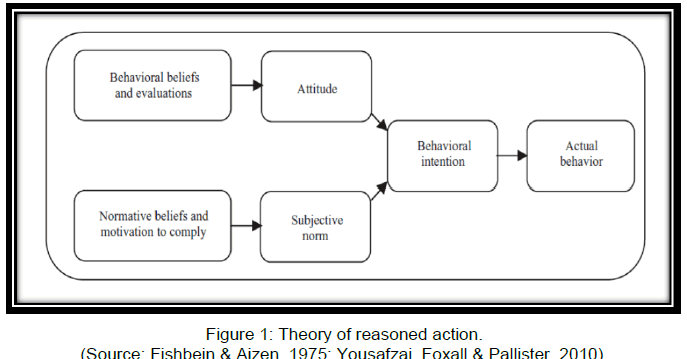 |
| Ozdemir and Trott, (2009) suggested that internet banking has been applied in different countries of the world. However, in some countries its implementation is more easy and acceptable because of certain factors such as risk factors and technological development. Similarly, Sayar and Wolfe (2007) suggested that the development of information technology and evolution of internet banking has changed the ways through which banks traditionally deliver customer services and implement their business strategies. Ortega, Martínez and Hoyos, (2007) researched that internet marketing facilitates customers in their daily life and professional life through funds transfer, bill payments and internet shopping. Internet banking has been expanding on a continuous basis as the traditional banks have started to offer a financial portal to their customers. The concept of portal bank has a start has offered a new role to banks to serve their customers. It is important to mention that having an internet does not mean that banks will generate a continuous stream of revenue rather they need to offer a reliable and wide range of services through internet (Cheung & Lee, 2006). |
| Regarding customer's perception towards internet banking, Hyun and Steege (2013) conducted a study and found several factors affecting internet banking. He found that past experience of customers towards internet banking, perceived risk in internet banking, perceived easiness in internet banking, perceived uncertainty in internet banking are important factors which may influence customer perception towards internet banking. Lichtenstein and Williamson (2006) investigated that internet banking is one of the most important factors for increasing customer base of the bank. This is because internet banking may attract customers from any where, and allows customers to operate from anywhere and anytime. Contrary to this study, Zhao et al (2008) conducted a study to identify detailed dimensions of service quality in the banking sector. These service dimensions are responsiveness, reliability, credibility, competence, courtesy, access, understanding the customers, communication, continuous improvement, ease of use, collaboration, accuracy, content, aesthetics, diverse features, security and timeliness. They study discovered that some dimensions of service quality are important for traditional as well as internet banking. These dimensions include reliability, responsiveness and access to banking services. In comparison to study of Woldie, Hinson, Iddrisu and Boateng (2008), this study gave a clear description and evaluation of traditional and internet banking services. |
| Jayawardhena (2004) also conducted a study to evaluate the service quality dimensions of internet banking. They worked on the SERQUAL scale for evaluating the perception of internet banking services. In this regard, they applied SERQUAL dimensions to internet banking and developed a scale consisting of 21 items for accessing service quality in internet banking. They condensed these 21 items into five dimensions of quality of internet banking services. These dimensions include website interface, accessibility, trust, credibility and attention. |
| In 2006, a study was conducted by IAMAI on internet banking for evaluating the customer response towards internet services. This study presented the clear view of the perceptions and attitudes of customers towards internet banking. This study concluded that 43% online users have not started using internet banking services because of inappropriate security mechanisms of internet banking. This study found that 39% online users have not started availing internet banking services because they prefer to use face to face online banking services. 22% online users have not shifted to online banking because they do not have knowledge about internet usage. 10% online users did not show interest in online banking services because websites of banks were not users friendly, and study found that 2% banks do not provide internet banking services. This study evaluated that 68% did not show their intentions about using internet banking services in future. In addition, it was found that most of internet banking services was used by males between the age groups of 25-35 years. It was found that percentage of female customers who prefer to use internet banking were very less about 17% (IAMAI, 2006). |
| Ho and Lin (2010) studied the critical incidents which caused customer satisfaction and dissatisfaction in internet based service encounters. Technology based services are often used by business to business companies. In business to customer organizations, number of internet users is very low. Similarly, Deng, Liao and Ma (2007) also found that technology based services are growing with great pace in business to business transactions. In this regard, a study in next year suggested that researchers need to discover the factors influencing customer satisfaction in business to customer segment in technology based business (Calisir & Gumussoy, 2008). |
| Kassim and Abdulla (2006) studied the perceptions of customers towards internet banking and drivers of internet banking or customers. It was an exploratory study to evaluate that how customers accept internet banking services and which factors improve the usage of internet banking services by customers. The results of this study suggested that gender, education and income of the customers are important factors which promote the use of internet banking services. Kassim and Abdulla (2006) concluded that if internet banking quality is improved, the customers will have increasing intensions of using internet banking. Many customers prefer to use internet banking services because of large scale benefits provided by technology based banking. Ozdemir and Trott (2009) have elaborated several benefits of internet banking such as convenience, cost efficiency and time saving. |
| Flavian, Guinaliu and Torre (2006) discovered that internet banking is highly accessible therefore, leads to increasing customer base for the organizations. This is because internet banking can be accessed by all, anywhere and anytime. It is less costly because it has eliminated several intermediaries which are in traditional banking system. The fixed cost which incurs in conventional banking such as premises and physical infrastructure do not incur in internet banking. In addition to fixed cost, variable cost such as employees of traditional banking also increases because of the increasing number of bank branches. Internet banking is not limited by time dimensions. Moreover, it is also self accessible by customers. In this regard, Ozdemir and Trott (2009) suggested that internet banking provides solution for several high cost conventional banking services. Customers can save their time and cost by availing intranet services (Kassim & Abdulla, 2006) this is because they can perform the internet banking transactions directly from their offices and homes rather than by visiting the banks physically. Calisir and Gumussoy (2008) also noted that increasing efficiency and ease of delivering internet banking services can lead to creating loyal customers. |
| For the banking services, the internet can serve as media of marketing communication. In this regard, the internet not only results in delivering services but also as media of advertisement for the banking companies. Calisir and Gumussoy (2008) have suggested that internet services such as information processing and communication of services can be performed efficiently through the internet rather than through traditional banking services. |
| Drennan, Sullivan & Previte (2006) have suggested that internet banking services are highly cheap for the banking companies. They categorically suggested that internet banking services cost one thirteenth of a teller transaction. Ho and Lin (2010) declared that from 1996 to 1998, internet banking services have remained stagnant because of inappropriate technology development and customer acceptability to use internet banking services. Sayar & Wolfe (2007) pointed out that the internet banking industry is still underdeveloped and at its infancy stage. This is the reason that there is no developed appropriate theoretical model and perspective regarding internet banking services. |
| Calisir and Gumussoy (2008) suggested that the banks which were the first movers in adopting internet banking services focused on the technological benefits of internet such as setup for implementing internet. On the other hand, Shaki & Gevers (2011) also suggested that the banks which avoided adopting internet technology were not aware of the benefits of internet. In this respect, Hernandez and Mazzon (2007) suggested that customers perceive service quality in relation to distinguishing the interaction of customers availing the service delivery and the quality of service outcomes in the case of internet banks. They also revealed that customers perceive internet banking services more convenient, less expensive and easy to use. To avail the convenience of internet banking, customers show their highest intentions to shift from traditional banking to internet banking services. |
| Shaki and Gevers (2011) revealed that customers avail internet banking because of its availability across 24 hours a day and 7 days a week. They also revealed that the aspects of internet banking from customer perceptions. Perceptions of customers regarding internet banking have large scale impact on the growth and development of internet banking. The attitudes, behaviours and perceptions of customers and compatibility of internet banking with the customer lifestyle have a large scale influence on the growth of internet banking. On the other hand, banks show high intentions to implement internet banking to reduce their cost which comes from paper work, quick response and efficient service delivery. Shaki and Gevers (2011) also revealed that the banking industry is the first industry which has recognized the benefits and potentials of internet banking (Hernandez & Mazzon, 2007). |
| The perceptions of customers regarding internet banking also influence the intentions of adoption of this mode of banking. The rate of internet banking adoption varies across several countries and also varies across several customer segments. ACNielsen (2002b) examined that the rate of internet banking adoption is increasing in the Asian countries. However, it is still lower than the estimations. Therefore, because of lower rate of internet banking adoption, the transformation of traditional banking services i.e. bricks and mortar to the technological banking services needs to be realized to the level at which they were predicted (Eriksson, Kerem, & Nilsson, 2008). Earlier studies also show that in some countries internet banking services are considered less important by the customers than other channels such as telephone banking and ATM (Ho & Lin, 2010). Therefore, it has become critical for the marketers and bankers to understand the critical factors behind the adoption of internet banking by the customers. Gikandi & Bloor (2010) suggested that the financial companies and the banks need to survey the customers to know their changing requirements on a regular basis. This is important to understand the factors which influence the rate of adoption of internet banking by customers. |
| While discussing perceptions of customers towards internet banking, the trust factor is a significant one. Zavareha et al (2012) suggest that trust of customers on online banking has is comparatively low because the two parties do not maintain face to face communication in this type of transaction. Trust is considered to be the important factor for both parties i.e. customer and bank because it leads to successful transaction and long term relationship between both parties. Kim et al (2010) have discussed that the uncertainty in customers’ mind regarding security of internet banking services reduce the customer trust over internet banking. In the earlier studies, several factors have been explored regarding low trust level of customers on internet banking. These are categorized as online systems’ security, uncertainty and high risk in online transactions (Chin et al, 2008). Trust not only refers to the idea that internet banking service provider is trustworthy but it also means points out the system probably web through which transactions are processed and carried is also trustworthy. |
| Grabner-Kräuter and Faullant (2008) have suggested that for successful transactions to accomplish, the web also needs to be trusted by customers along with the internet banking service providers. Hence, building trust with the customers is a crucial factor for the banks. In this consideration, Lee (2009) has pointed out that internet banking service providers need to design an online system in relation to the customer requirements and concerns about the uncertainty and risk factor. |
| While discussing perceptions of customers towards internet banking, Chin et al (2008) reveal that customers do not trust internet banking services because of two factors; reliability and security. Security is considered to be the most important and common factor which may turn on the perceptions of customers about unwillingness to adopt internet banking services. Kim et al (2010) found that most of the customers do not trust the web because of holes in its security mechanism. In this regard, resolving security concerns is the most crucial factor in future for the development of internet banking services because customers perceive high risk in using internet for completing the financial transactions (Lee, 2009). While discussing about the perceptions of customers, Chang and Chen (2009) have revealed that the potential adopters of internet banking services perceive that the technological solutions are not secure and safe and can cause mistakes and errors in accomplishing the transactions. Therefore, there are more likely not to adopt the internet banking services. |
| Norzaidi and Sabrina (2011) have discussed that the security dimensions are highly important for converting negative perceptions of customers towards positive perceptions regarding internet banking services. This is because security has a positive relation to the adoption of internet banking services. In this regard, Hua (2009) suggests that the immediate need for bankers is to reduce the risk and frauds in the internet banking. By doing so, bankers can improve customer confidence and customer retention. High security and reduced risk in internet banking makes customers to perceive internet banking as secure and accessible delivery channel. Similarly, Goi (2007) has also suggested that the perceived reliability of customers towards internet banking has a positive influence on the internet banking adoption rate. |
| Customer perception of internet banking is also influenced by credibility factor. Credibility refers to the idea the person finds form the other person which is desired. In banking case, credibility aims at building a positive reputation of banks and transferring high confidence to customers regarding internet banking services (Shaki & Gevers, 2011). Customer may have several concerns and security issues in their minds which may turn on their negative perceptions regarding internet banking (Liao and Cheung¸ 2008). However, if bank’s credibility is high, the customers are more likely to be assured that the transactions with the bank will be safe and secure. On the other hand, if the credibility of the bank is low, it is more likely that the customers will develop negative perceptions about the bank. While evaluating credibility, Hua (2009) has discussed two important issues which are privacy and security. He suggests that if banks assure that customer data will be kept secure and private, the chances of mishaps or inconsistency in the internet banking service delivery will be less. On the other hand, security in internet banking refers to the idea that personal information and financial data of customers will be in safe hands and will not be misused (Norzaidi & Sabrina, 2011). The factors that create negative perceptions in the minds of customers regarding internet banking, insecurity of information are the most important. Therefore, bankers need to resolve the concerns of customers regarding security and privacy. |
| Technology Acceptance Model (TAM) |
| For understanding, predicting and explaining why individuals/consumers acknowledge or refuse using of information systems; scholars developed several models in that regard, by Marina (2009) one of the most useful model in that regard is given name of the technology acceptance model (TAM), actually this model helps a lot in identifying and categorizing the factors which affect individuals for accepting or refusing use of technology applications. Whereas Sheikhshoaei and Oloumi (2011) indicated two models, they are the Technology Acceptance Model (TAM) and the Task Technology Fit model (TTF) which is frequently used by entities/organizations for explaining the acceptance of e-banking by consumers, actually these models offer quite dissimilar but occasionally overlapping point of views on the utilization behaviour of these electronic channels. By Sheikhshoaei and Oloumi (2011) the Task-Technology Fit model associates technology with performance and imagines that level of performance would go up when a given technology gives features and support that correspond with the requirements of the task. As a result for banks, they would take on e-banking technologies if it supports in delivering superior quality services to consumers. |
Technology Acceptance Model (TAM) |
| By main objective offered by TAM model is to offer comprehensive clarification of factors which affect computer-applications’ acceptance generally, and it also supports practitioners for identifying why a precise organism is intolerable and undesirable. Marina (2009) proposed that utilizing any type of information system is in a straight line determined by the behavioural purpose of using it, which is in turn affected through the users' attitudes in the direction of utilizing the system and the perceived usefulness of the system, attitude and perceived usefulness are also affected by the perceived ease of use. By Rosenberg (2011) in accordance with TAM model, bigger level of perceived usefulness and the perceived ease of using an information system would optimistically influence the attitude in the direction of this system, the attitude, in turn shows the way to a bigger intention of using the system, which optimistically influences one's authentic use of the system. |
| TAM model actually assumes that, other-thing being equal, perceived-usefulness is influenced through the perceived ease of use for the reason that the easier a technology system to utilize, the more constructive and helpful it can be. Perceived usefulness can be describe like the extent to which consumers believe that utilizing a precise system would help to a great extent in enhancing their job-performance. Perceived ease of use actually defines the extent to which consumers believe that utilizing the technology system will-be free of effort (Rosenberg, 2011). Attitude (ATT) gives details about consumer’s positive or unfavorable evaluation about the behaviour in question, Intention (INT) can be define as a measure of the strength of consumers readiness for using effort while-performing a certain behavior. Whereas in TAM model external variables point to such variables which have capability of influencing information-system acceptance ultimately by perceived-ease of use and perceived usefulness (Gregg & Luke, 2010). According to Marina (2009) constructs of TAM are almost measured in the same way in every context, in addition, TAM model is a consistent tool and empirically sound. Quite a few meta-analysis research works have given adequate amount of data regarding TAM to be extremely plausible and realistically explain up to forty percent of the behavioralintention to use. In addition, quite a lot of research works have applied TAM for evaluating consumer’s adoption in diverse settings for example e-commerce (Hearn & Hearn, 2008); e- learning, internet banking and e-government (Azouzi, 2009). |
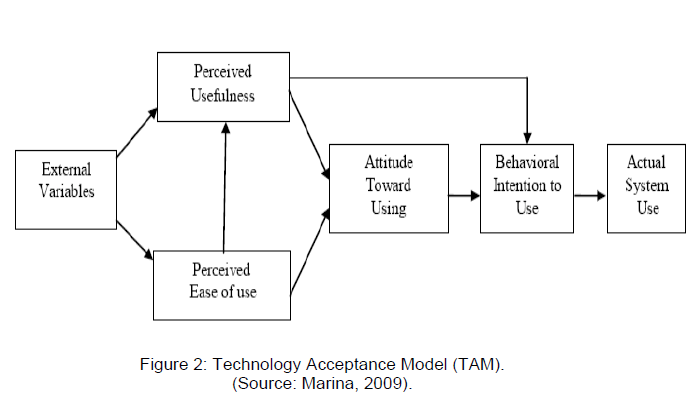 |
| Theory of Planned Behavior (TPB) |
| According to Warrington and Derrick (2010), the theory of planned behaviour (TPB) proposed that human behaviour is determined through purpose of performing the behaviour, which is influenced mutually through attitude in the direction of behaviour, subjective custom and perceived behavioural control , attitude (ATT) can be also as a broad sentiment of human regarding the attractiveness or undesirability of a precise behaviour, actually subjective norm (SN) states the perceived organizational or social stress of a person who plans of performing a precise behaviour. Perceived behavioural control (PBC) actually imitates a consumer’s insight and awareness of the ease or complicatedness of executing a precise behaviour, the capability of TBP in giving a helpful hypothetical outline to understand and predict the acceptance of fresh information systems is made obvious (Warrington & Derrick,2010). Gregg and Luke (2010) investigated earlier studies using the TBP in a meta-analysis study; the main conclusion was support for the efficacy of the TPB and the suggestion that more work on new variables is necessitated for increasing the inevitability of the model. |
| Though the above given technology acceptance models help organizations (banks) in identifying what exactly consumers consider before adopting a new thing, technology application, but they are just a general type of models. Britain is a developed country where people/consumers from almost all over the world come here, so in presence of multicultural environment it is essential for banks to use any other advanced tool instead of just TAM model or TPB model, and it is essential to take into account multiple dimensions in that as it is not easy to evaluate likings and disliking of consumers in a multicultural market towards online banking area. . . . . . . . . . . . |
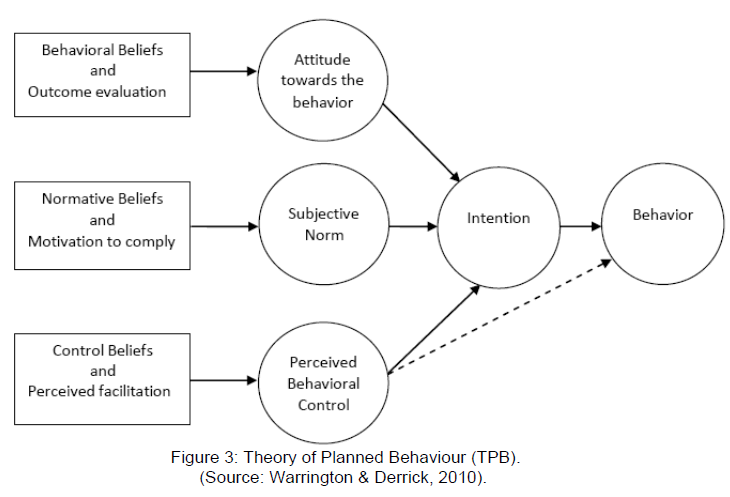 |
| Chapter Summary |
| In conclusion, it is said that literature findings have demonstrated that customer perception towards internet banking may be influenced by many factors. The earlier literature has focused on the issues of trust, security, credibility, privacy and security while discussing the customer perceptions towards internet banking. Moreover, the convenience and usefulness of the internet banking services also develop the positive perceptions in the minds of customers regarding internet banking. It has been found through existing literature that the customers are more likely to develop positive perceptions regarding internet banking services if the banks assure about security, convenience, and privacy of information. In addition, the trust factor is also found as important influencer towards internet banking. |
RESEARCH METHODOLOGY |
| This particular research has been conducted to evaluate the perceptions of customers towards internet banking in the United Kingdom. In this chapter, the methodology selected in this research has been critically discussed and justified. The research approach, strategy and data collection methods used in this study are also evaluated and discussed. Finally, the validity and reliability of the research instrument are also discussed. The limitations of the research are also discussed in this chapter. |
| Research Approach |
| Lancaster and Geoffrey (2009) have noted two types of research approaches for the conduction of a research. These are inductive and deductive research approaches. The deductive research approach refers to the way through which existing theories and models are discussed and evaluated. Under this approach, hypothesis are developed from existing theories and models and tested statistically or mathematically for the approval or disapproval of the hypothesis. On the other hand, inductive research approach refers to the development of hypothesis through experiments and observations and further tested for the evaluation of results. Deductive research approach discusses a specific idea through existing theories and models and move towards the generalization of the results (Saunders et al., 2009). On the other hand, inductive research approach refers to the way through which problems from a general point of view are discussed and results are reached at the particular point of view. In this study, perceptions of customers towards internet banking in the United Kingdom have been evaluated through inductive research approach. Through the questionnaire survey, data will be collected and perceptions of customers regarding online banking will be evaluated. This study is based on the inductive approach because it has aimed to evaluate the perceptions of customers of the United Kingdom regarding online banking. |
| Research Strategy |
| The research can be conducted through qualitative or quantitative research methods. This particular research has been conducted by a strategy in which qualitative and quantitative methods are included. Saunders et al (2007) noted that qualitative research methods investigate a particular research problem in detail. In addition, these methods discuss the research problems in words instead of discussing the matter in numerical words. In this research, qualitative research methods are used in this study to conduct a detailed discussion on the online banking models and theories. In addition, the qualitative research methods are also used to collect data from management respondents in detail. Bryman and Bell (2007) have noted that quantitative research methods investigate a particular issue through facts and systematical approach. Quantitative research involves facts and numerical data collected through interactive research tools such as surveys (Bryman & Bell, 2007). In this study, quantitative research methods are also used for investigating the perceptions of customers towards internet banking in the United Kingdom. The quantitative research methods also involve analysis of research questions through statistical or mathematical tools. However, in this study simple tool of mathematics and statistics has been used for analyzing the data. In this particular study, qualitative and quantitative research methods are integrated with each other. The analysis of quantitative data has been conducted through detailed discussions which represent the quantitative research methods. In this way, detailed and logical results of perceptions of customers towards internet banking in the United Kingdom can be found. |
| Data Collection Methods |
| Lancaster and Geoffrey (2009) have noted that there are two types of data. These are identified as primary data and secondary data. The primary data refers to the data which is collected by the researchers through interactive research instruments such as surveys and interviews. |
| Primary Data Tool: Survey Tool |
| Primary data are called first hand data because it is collected for the first time. Saunders et al (2007) has noted that primary data has low bias factor because it is not processed or evaluated by earlier researchers. It represents the fresh results because of the freshness of data collected through primary data tools. In this study, primary data have been used because perceptions of customers regarding online banking in the UK cannot be evaluated appropriately without using first hand data. |
| The primary data can be collected through several tools such as surveys, interviews, observations and focus groups. In this study, all of these tools are not used. This study is based on the evaluation of perceptions of customers towards internet banking in the United Kingdom. Therefore, data have been collected from customers. The selected data tool for this research is survey. This is because survey tool is appropriate for the evaluation of research aims and objectives. There are some strengths and weaknesses of survey tool. In this study, survey tool has been selected because of following strengths (Lancaster & Geoffrey, 2009): |
| • Survey tool has very low bias factor because the researcher does not interact with the participants to a great extent. |
| • The cost required to conduct the survey is very low because the researcher does not require any appropriate arrangement for the collection of primary data. |
| • Survey tool is highly flexible for the collection of primary data. This is because through a single questionnaire data from a large population can be gathered in a small duration. |
| • Data regarding personal respondents and other facts can also be gathered through survey. It can take more time to collect factual data through other tools such as interviews and focus group discussions. |
| Despite of strengths of the survey tool, there are some weaknesses of this tool. Some of the weak points of the survey are as follows (Lancaster & Geoffrey, 2009): |
| • The responses of participants are considered final and the researcher does not have any opportunity to ask clarification of the responses. |
| • The inappropriate construction of the questionnaire for the survey can undermine the complete study. |
| • The researcher cannot collect detailed information regarding the subject of research. |
| In this particular study, survey tool has been used by overcoming the above weaknesses. The construction of the research instrument is done appropriately. The language used in the questionnaire is very clear and does not include ambiguity. In this regard, the weaknesses of the survey tool are surmounted. |
| Questionnaire Design |
| The survey can be conducted through open end questionnaire or close end questionnaire. Open end questionnaire generates qualitative data whereas close end questionnaire generates quantitative data. In this study, quantitative data is required therefore close end questionnaire has been prepared. The questionnaire is composed of two sections. The first section includes personal profile of the respondents. For the evaluation of the perceptions of customers towards internet banking in the United Kingdom, personal profile of respondents is highly required. This is because the relationship between certain online banking dimensions and personal profile of respondents can effectively determine the perceptions of customers towards online banking. The factors derived through theoretical models of online banking have been included in the questionnaire to evaluate the perceptions of customers regarding online banking. |
| Secondary Data |
| Secondary data refers to information which is present in the earlier sources (Saunders et al, 2007). The main characteristics of secondary data include high bias factor, low cost and easy accessibility. In this particular study, secondary data has been included to discuss the theoretical models regarding online banking. This literature review of this study has been constructed with recent secondary data. In this study, secondary data has been collected through the following sources: Books, Recent Journal articles and Website sources. |
| Sampling and Population |
| From the collection of primary data, selection of samples is mandatory. The targeted population of this particular research is composed of customers of banks in London. As there are many banking customers in London therefore, it is important to select an appropriate sample. In this particular study, a sample of 100 customers has been selected through convenience sampling. The convenience sampling technique refers to selection of sample on the basis of convenience available to the researcher. The researcher approached to the respondents who were conveniently available and accessible. Some authors and researchers argue that convenience sampling is not appropriate for the selection of sample because it may generate bias factor. However, the researcher has selected sample of 100 respondents from different places and on different occasions. In this way, a diverse and unbiased sample has been selected for this study. |
Validity and Reliability of Research |
| In this particular study, the factors of reliability and validity of research instrument have been carefully considered. The research instrument is also developed by considering validity and reliability dimensions. The validity of research refers to the idea of correctness and legitimacy of the research instrument (Dallas & Grimmer, 2007). The methodology adopted for this study is coherent and aligned. This has contributed to the validity of the research. In addition, the researcher has also considered the aims and objectives while developing the research instrument. In this way, correctness of research instrument is insured. |
| The reliability of the research is defined as consisting of research findings and instrument (Lancaster & Geoffrey ¸2009). In addition, the truthfulness of research findings is also called reliability of research. For ensuring reliability of research, data from truthful sources has been collected. In addition, the data are also collected regarding the aims and objectives of the research. |
| The reliability and validity of research instruments ensure that this particular research has followed all appropriate considerations of the research. |
Ethical Considerations |
| Ethics are defined as the moral values which determine that what is right and what is wrong. It determines the extent to which researcher has followed the honesty and moral values while data selection, data analysis and representation of findings. |
| While selecting primary data, the researcher has not used pressurized approach. The researcher has not adopted any practice and tool which can cause the environmental or physical harm to research participants. The researcher has selected the approach and tools of data collection while considering the safety of the participants. The researcher has asked the respondents to provide the data without any influence and pressure. |
| During the data collection process, the researcher has ensured the respondents about the confidentiality of data. The researcher has not asked very personal questions such as names and address of the respondents. In addition, data is secured with password protected systems so that it cannot be stolen by anyone. |
| The researcher has used appropriate methods for analyzing the primary data. The researcher has not conducted any inappropriate data analysis tools in this study. Fair and just analysis methods have been used in this research. |
| The above considerations suggest that the researcher has conducted fair and clear methods for data collection and analysis for complying with the ethical considerations. |
DATA ANALYSIS |
| The data has been collected from 100 customers of different banks located in London. The response rate achieved in this study was 73% which was satisfactory for conducting a research. In this chapter of research, data collected through survey has been analyzed in an effective way. For data analysis, the research findings are reverted back to the literature review. In this way, this chapter also establishes a relationship between primary and secondary data findings. |
Questionnaire Findings |
| Gender of Participants |
| The outcome of a survey disclosed that 56% of the total participants were females whereas 44% were males. The purpose of asking the gender of the participants was to look into the perceptions of males and females towards internet banking. |
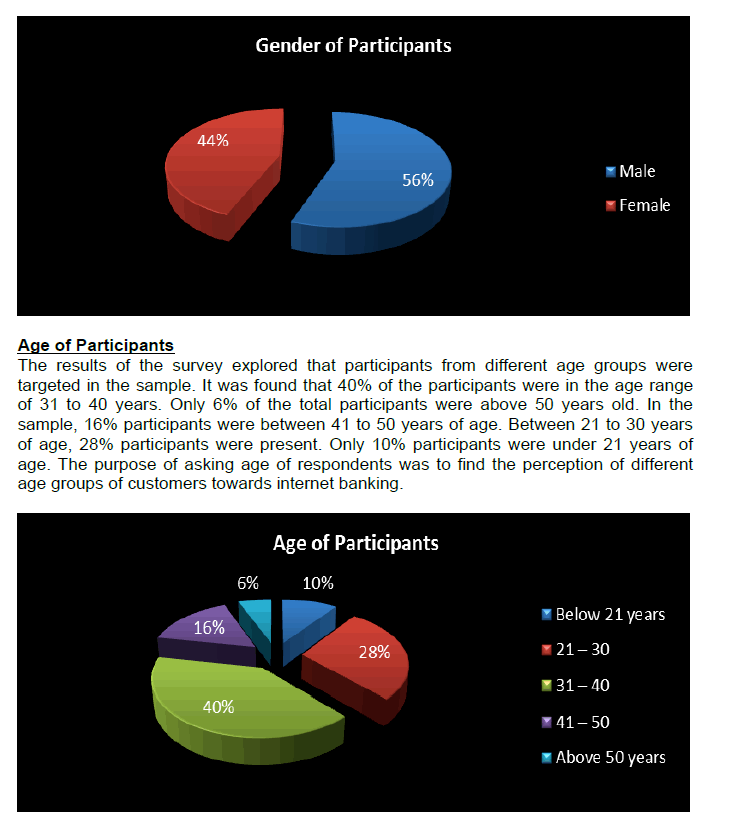 |
| Qualification of Participants |
| The respondents were also asked to mention their qualification. The purpose of asking this question was to assess that whether qualification influences the perceptions of customers towards internet banking. The results revealed that 20% of the respondents were high school qualified and 39% were qualified with a college degree. 31% of the total participants were having Master’s Degree. The rest of the respondents were either equipped with certain technical diplomas or were having lower school diplomas equivalent to matriculation or A Levels. |
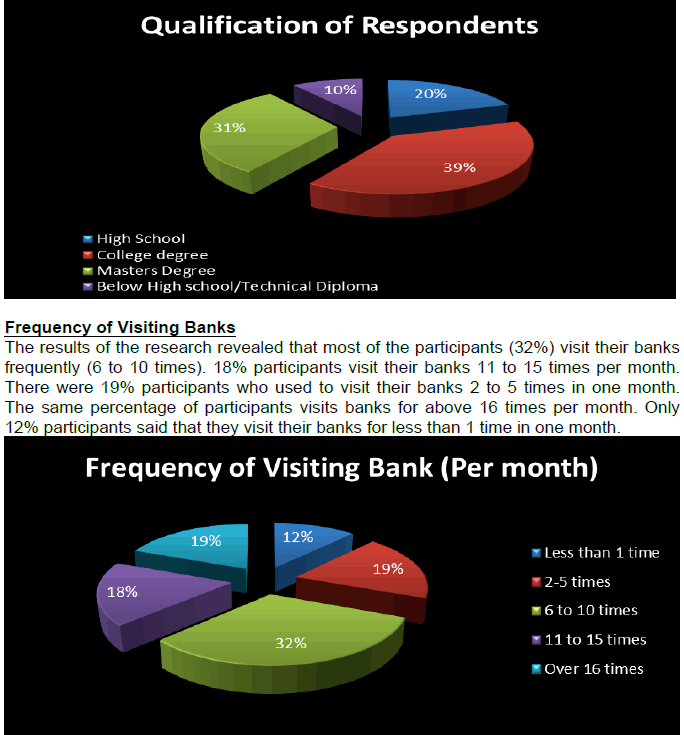 |
| Reason of Visiting Banks |
| The results of the research revealed that a large percentage of participants used to visit the banks for making the deposits (45% of total participants). 24% of total participants pointed out that they visited their banks for withdrawal of cash. 15% participants visit banks for inquiring about their bank balance. The percentage of participants that used to visit the banks for taking advice regarding investment options was only 10%. The rest of the participants visit the banks for some other purposes. |
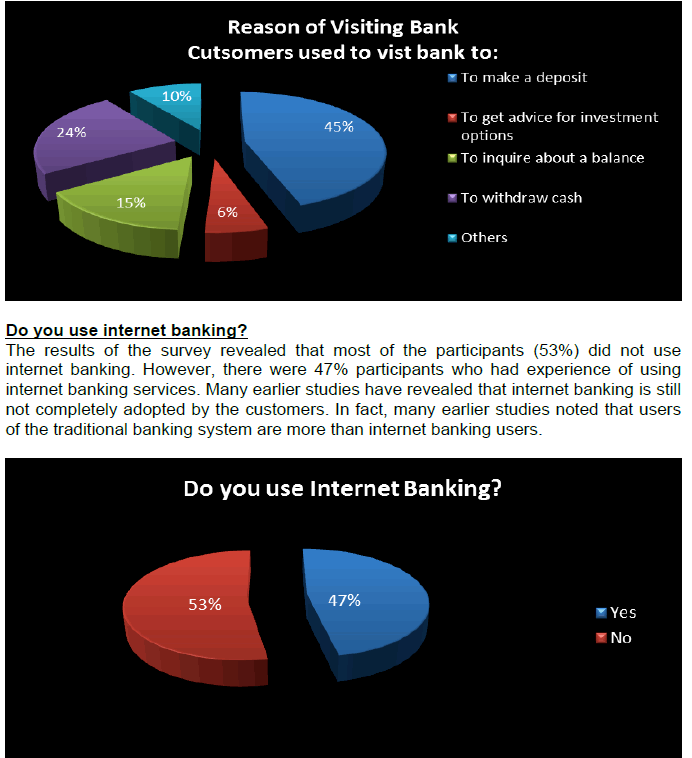 |
| What is the main reason for not using internet banking? |
| The participants who did not use the internet banking services explored that the major reason for not using the internet services is a security concern. Some participants (who were below college level and were below high school qualified) revealed that the internet banking is not convenient for them. These findings revert back to Hua’s (2009) study who found that lack of knowledge and awareness about the use of internet banking is a major influencing factor behind resistance to use internet banking. The results of the survey also clarified that the same respondents showed their concerns about the privacy issues which resist them to use internet banking services. |
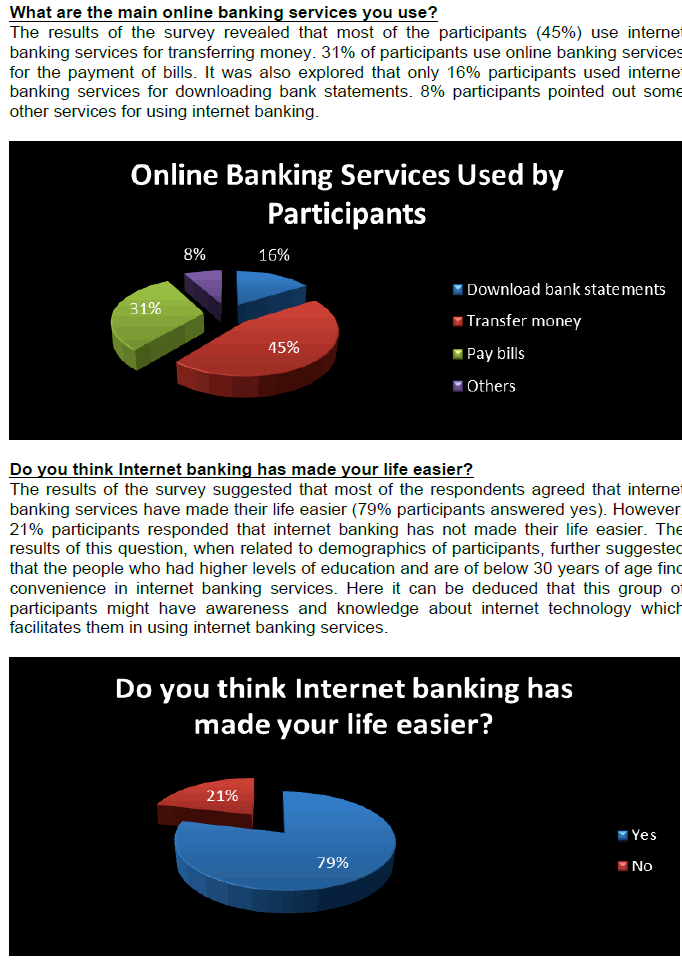 |
| However, older age participants (above 50 years) did not find convenience in their lives because of internet banking. This reverts back to the study of Hyun and Steege (2013) who suggests that older age people do not have higher knowledge about the internet banking. However, in recent studies, the convenience of internet banking has been highly demonstrated (Hyun & Steege, 2013). In perspective of age, it can be deduced that the older people might have more concerns regarding security of where money therefore, they are less likely to avail internet banking services. |
| On financial basis, online transactions are secure? |
| The results regarding secure transactions revealed that most of the participants who used internet banking find it secure. 30% of participants strongly agreed, 59% agreed and 5% disagreed that financial transactions over internet banking are secure. 6% participants were impartial and no one strongly disagreed with this statement. Financial security is highly crucial factor for the success of internet banking. The earlier studies of Lee (2009) also declared that customer seeks for secure transactions whether through online or offline banking. |
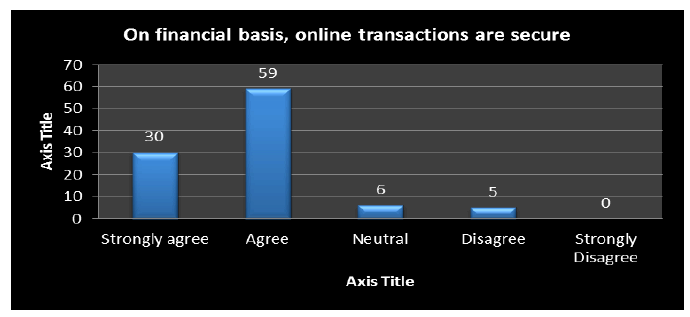 |
| I find internet banking facilities easiest way of financial transactions as compared with the traditional banking services such as ATM and credit cards. |
| The survey findings revealed that most of the respondents seek convenience in the internet banking in comparison with the traditional banking services such as credit cards and ATM. 29% of participants strongly agreed, 38% agreed and 19% disagreed that internet banking is convenient in comparison with the traditional banking services. However, 8% participants strongly disagreed and only 6% remained undecided in their response. The results are aligned with the findings of previous questions in which it was revealed that educated participants found internet banking convenient because they had knowledge and awareness of the internet banking. The participants from upper age categories and many female participants disagreed on this question. Regarding comparison of traditional and internet banking services, Gikandi and Bloor (2010) pointed out that most of people avail internet banking service because it is convenient to operate and saves time. |
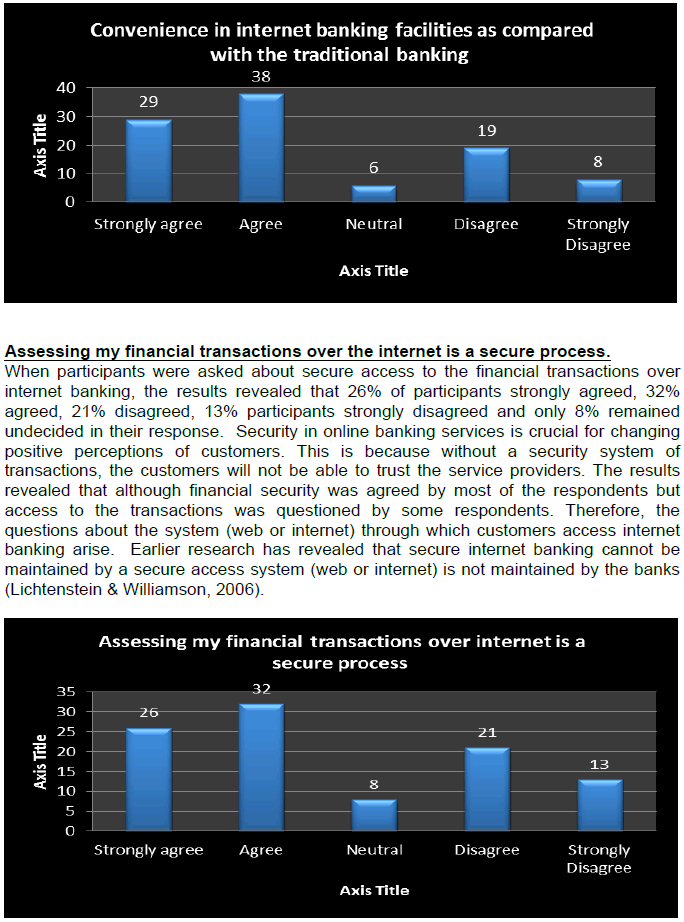 |
| There is high uncertainty in the bank’s mode of internet transactions regarding errors. |
| Uncertainty in internet banking refers to the vagueness in the processes through which transactions will be completed. Moreover, it also defines the elusiveness in the errors or appropriateness in the completion of the transactions. Uncertainty in errors in internet banking was identified by many respondents. In this regard, 8% of participants strongly agreed, 12% agreed, 26% participants strongly disagreed, 42% disagreed and only 12% remained undecided in their response. It was found that uncertainty in the internet banking was not perceived by most of the respondents. The results evaluated that a large percentage of participant’s perceived that internet banking was not uncertain. The results from secondary data also supported that the non-users of internet banking perceive high uncertainty in this mode of transactions. However, a small percentage of respondents still perceive uncertainty in internet banking. The bank needs to resolve the uncertainty concerns of this customer group to improve the effectiveness of internet banking. |
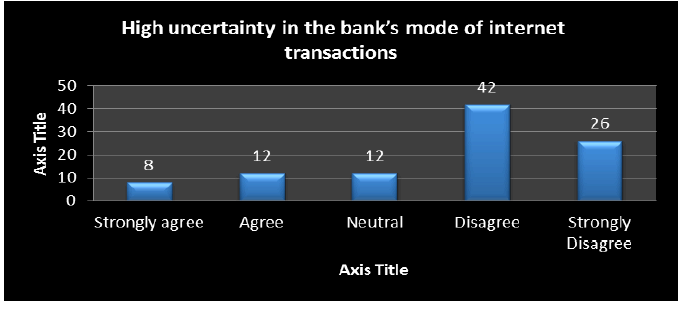 |
| I have substantial privacy when using internet banking services. |
| Privacy refers to the idea that personal information of the users is kept confidential and not misused for any inappropriate purpose. In the absence of privacy concerns, the customers are unlikely to transact through internet banking. The respondents highly agreed that they had substantial privacy when using internet banking services. The results of the survey revealed that 38% of participants strongly agreed, 53% agreed, 3% participants disagreed and 6% remained undecided in their response. As the results confirmed that the privacy concerns are banks maintains privacy concerns of the customers while they transact through internet banking. The literature review has also confirmed that the privacy concerns are very important if they adopt internet banking. If appropriate mechanism is not adopted in the banks to maintain the privacy issues of customers, it is more likely that customers prefer traditional banking. |
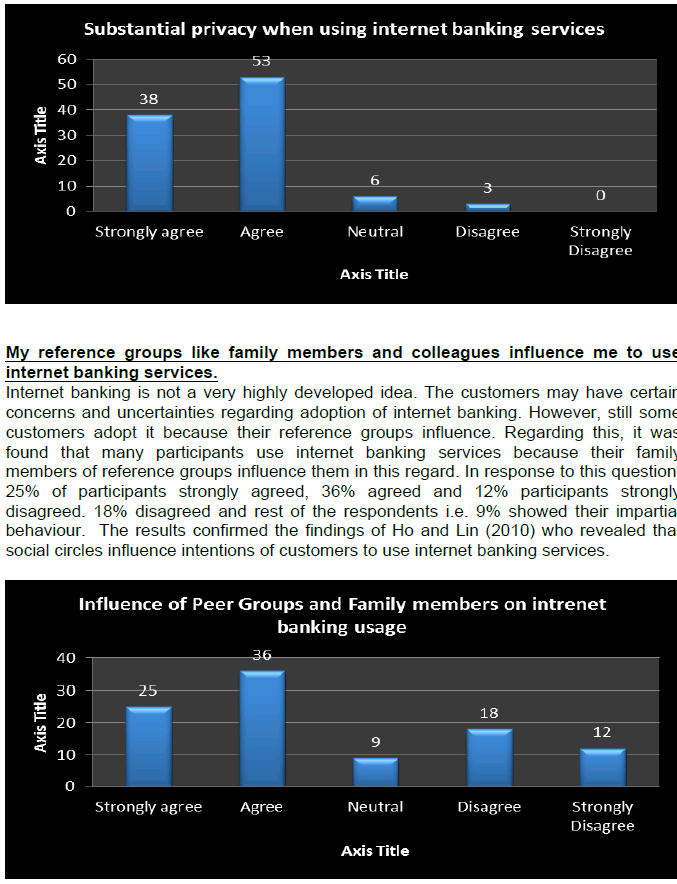 |
| Internet banking service providers are committed and keep their promises. |
| Reliability in services is highly important whether discussed in online or offline banking. When respondents were inquiring about the commitment and the promises of theinternet banking service providers, most of the participants agreed that service providers keep their promises. 24% of participants strongly agreed, 38% agreed, 10% participants strongly disagreed, 21% disagreed and only 7% remained undecided in their response. For the successful internet banking services, it is highly important that banks must provide reliable and consistent services and keep their promises and commitments. In this regard, some of the respondents disagreed which suggest that banks need to improve its commitment level to meet the expectations of customers. The results from secondary data have evaluated that the promises of banks regarding reliability and efficiency services influence customers to shift towards internet banking. In addition, it is more likely that when a bank fulfils the commitment level of customers through traditional banking, it will also meet the expectations of customers through internet banking services. |
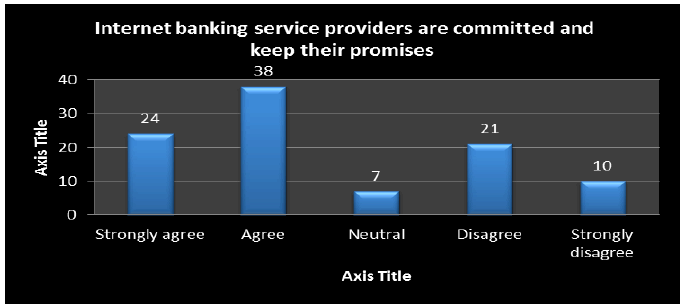 |
| I expect that my behaviour of using internet banking services will continue in future. |
| Finally, the respondents were asked that whether they will continue to use internet banking or not. The internet banking users revealed that they will continue to use internet banking services in future. In this regard, 26% participants showed strong agreement and 41% participants agreed. The results also showed that 9% participants were in strong disagreement and 15% were in disagreement. The rest of the participants were impartial while describing their future intentions for using internet banking services. Most of the respondents agreed to continue using the internet banking in future because they have satisfied their security and privacy concerns regarding internet banking. In addition, they also perceive that internet banking is time convenient and secure. |
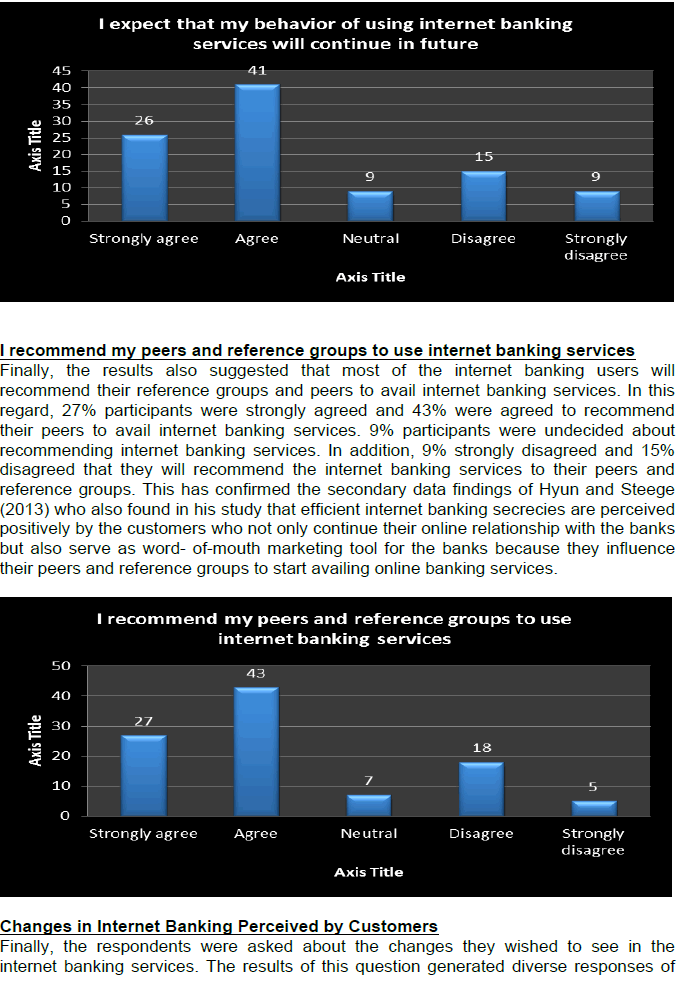 |
| the customers. The major concern highlighted by the participants was about the delays in delivery of services. The participants suggested that the banks need to improve their efficiency to confirm the transactions because most of the time transactions have actually completed but the customers did not get a confirmation message from the bank. It was also suggested by customers that the banks need to have an internal security mechanism and more technological development to assure customers regarding privacy and security of internet banking services. Moreover, some respondents suggested that the banks must offer convenient and easy processes to adopt internet banking because complicated processes of operating internet bank result in delay in services. On the whole, the changes identified by the respondents included improvement in time efficiency of internet banking services, development of an internal security system and offering more convenient processes. |
CONCLUSION |
| This particular research has been conducted to evaluate the perceptions of customers towards internet banking in London. The research reflects the particular attitudes and behaviours of customers towards internet banking. In this chapter of research, findings are summarized and concluded to derive the answers of research questions. In addition, the results of this particular research also correlate with the findings of earlier researchers listed in the literature review to illustrate the similarities and differences between the primary and secondary data findings. Finally, on the basis of research results, recommendations have been proposed. |
| This particular research has been based on qualitative and quantitative research methods. In alignment with these methods, secondary and primary data were used for the evaluation of perceptions of customers towards internet banking. The primary research was conducted with a sample of 100 customers selected from London which generated a response rate of 73%. Through appropriate analysis of the research data, research questions are answered as follows: |
| • Internet banking has evolved gradually with the evolution of internet technology. However, it was revealed that the internet is not a very old concept in the banking history. In the late 1980s, banking companies and financial institutions started to incorporate the internet in their services. Although internet banking emerged in the late 1980s but its rules and regulations are still developing and evolving. |
| • Security concerns are highly important for the customers while dealing in financial transactions because of involvement of money in the transactions. The literature findings have revealed that the customer may have uncertainty regarding delivery of reliable services and products. The security in internet banking also impacts the level of trust of customers on the internet banking system. In the literature review, several studies have been quoted which revealed that the customers seek for reliability and security in internet banking (Goi, 2007 & Hua, 2009). |
| • The survey results have been analyzed through descriptive analysis techniques. Through critical analysis of the survey results, it was found that most of the respondents perceived internet banking a secure, convenient and reliable mode of transactions. The survey results revealed that most of the respondents agreed that the internet banking is convenient for them. However, some respondents (compared older) disagreed regarding convenience factor. It has been concluded that these respondents might not have enough knowledge to use the internet that creates difficulty for them to use internet banking. It was also found that most of the respondents perceived security while transferring money through internet banking. In addition, privacy and reliability in internet banking were also perceived by most of the respondents. The results of the survey also revealed by most of the respondents that banks need to keep their commitments and promises while delivering services through internet. In the last, most of the respondents suggested that they will continue to avail the internet banking services in the future and will also recommend their peer groups to avail internet services. All these findings suggest that customers perceive internet banking positively. |
| • The results of the research are aligned with the results of previous studies. In several previous studies, privacy, security and reliability in internet banking has been emphasized by the researchers as these variables are demanded by customers in internet banking. For instance, Hua (2009) discussed that internet banking services need to demonstrate high privacy and reliability. Likewise, Goi (2007) also suggested that internet banking must be reliable. Hyun and Steege (2013) an Ozdemir and Trott (2009) emphasized that the internet banking is convenient for providing solution of customer problems. All these secondary findings support the results of the primary research. The results of primary research regarding demographics and internet banking perceptions of customers revealed that the older customers were comparatively more likely to disagree with the convenience dimension. These results are aligned with the findings proposed by Gikandi and Bloor (2010). |
| This particular research has contributed to the existing literature by demonstrating different factors affecting the perceptions of customers towards internet banking. Although several previous studies have also listed these factors regarding internet banking but these are not demonstrated in a single study. In this regard, this particular study adds knowledge in the field by elaborating privacy, security, convenience and trust perceptions of customers towards internet banking. |
LIMITATIONS OF STUDY |
| Despite of adopting an appropriate and fair method and approach for this particular study, there are some limitations of the research methods. Following is the description of research limitations: |
| The results of research are confined to the responses of participants. |
| The sample size of the research was very small i.e. 100 which generated a response rate of 73%. This small sample was selected from the banking customers of London. This small and geographically concentrated sample is not sufficient to generalize the results of the study to a larger sample. |
| The technique used in this research is a survey which is based on close end questionnaire. This research tool is not adequate to take out detailed opinion of research participants. |
| This particular study has not incorporated the viewpoint of management of banks regarding their measures to offer internet banking services. |
| FUTURE RESEARCH PROSPECTS |
| The limitations of the research can be overcome by the future study of the same topic. The future researchers can extend the knowledge boundaries of this research by taking a larger sample. In addition, they may also involve a geographically diverse sample from different cities of the country. Moreover, the future researchers may also expand the current study by using a different research tool such as open end questionnaire or interview. By incorporating these factors, future researchers can add more knowledge in the current study. |
RECOMMENDATIONS |
| On the basis of the above analysis, the following recommendations have been proposed to the banking sector for improving the internet banking services in alignment with the perceptions of customers: |
| • The banks are recommended to improve their security features and precautionary measures for providing reliable services to customers (Hyun & Steege, 2013). By granting secure and reliable services, the banks would be able to assure customers that internet banking is safe and secure. The banks can shift the negative perception of customers into positive perception by emphasizing security measures in the marketing campaign. The banks should communicate effectively with the customers that their security measures are strong and eliminate the instructions by third party. The internet banks also need to elaborate their internal security mechanism from a customer view point to emphasize their strong security procedures. This will result in positive perception of internet banking customers regarding security measures. |
| • The internet security breach does not necessarily comes from loose security measures of banks rather improper use of bank account details from customers may also result in security breaches (Ho & Lin, 2010). In this regard, it is recommended to provide training to customers regarding safe use of internet banking. This will enhance the confidence level and trust perceptions of customers on internet bankers. |
| • Another implication of the research findings to internet banking is about the convenience perceptions of customers. The research has revealed that some respondents disagreed regarding convenient internet banking services. In this regard, the internet banks need to train the incumbent internet customers regarding safe and appropriate use of internet banking services. In this way, the new customers will feel it convenient and easy to use the new services and this will result in the retention of these new customers by the internet bankers. |
| • Some banking customers disagreed regarding the certainty of the banking services. In this regard, it has been recommended that the internet bankers need to demonstrate and assure that the banking services are always available and reliable (Calisir & Gumussoy, 2008). In this respect, they need to elaborate the periodic maintenance of the routine faults and blockages in the banking services. |
| • Another important managerial implication of the research for the banking sector is to assure customers that the internet banking is trustworthy and caters their needs. This needs to be accomplished through establishing a close contact with the customers. The banks need to take measures such as loyalty programs and membership programs for assuring customers that they are valuable assets from the banks. This will result in positive perceptions of the customers towards bankers. This will also result in the creation of positive word of mouth marketing of the internet bankers and will communicate a positive message to the public. Moreover, the existing customers of the internet bankers will also use the internet banking services to a greater extent. Moreover, positive perceptions of customers will also make the, to recommend the internet banking services to their peers and reference groups. |
| Introduction of 100% risk free banking: The concept itself explain what it means. In the results and finding section of the report, it was revealed that number of people doesn’t use internet banking due to security risk. To attract these customers, banks should offer risk free internet banking. This mean if a fraud occurs during online transaction, genuine customers should not be affected. Banks can protect their customers by buying a valid insurance. This concept will not give rise to insurance industry but also contribute to save money banks spend on developing anti-virus and anti-hacker systems. |
| ACKNOWLEDGMENT |
| The work presented in this paper was done as part of MBA Finance dissertation submitted to University of Gloucestershire, UK in 2013 under the supervision of Senior Lecturer Marie Byrom. The author would like to express his sincere gratitude to supervisor for her useful guidance, insightful comments, considerable encouragement and valuable support. The author would also wish to send his appreciation to all research participants. Without their valuable opinions on the questionnaires, the research would not have been accomplished. |
References |
|
Copyright © 2025 Research and Reviews, All Rights Reserved